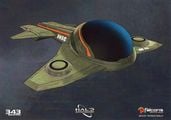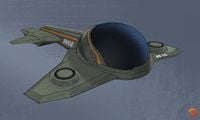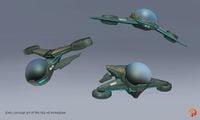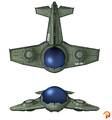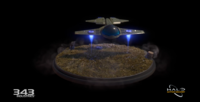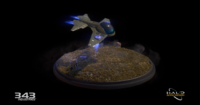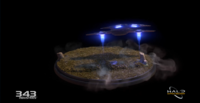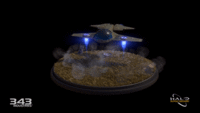OQ-45 Honeybee
From Halopedia, the Halo wiki
| OQ-45 Honeybee | |
|---|---|
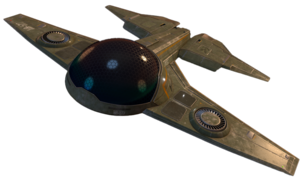
| |
| Production information | |
|
Model: |
OQ-45 |
| Technical specifications | |
|
Length: |
7.6 meters (25 ft)[1] |
|
Width: |
6.4 meters (21 ft)[1] |
|
Height: |
2.2 meters (7.2 ft)[1] |
|
Mass: |
1.35 metric tons (1.33 LT; 1.49 ST)[1] |
|
Maximum speed: |
500 kilometres per hour (310 mph)[1] |
|
Engine(s): |
Hybrid Fusion drives[2] |
|
Other system(s): |
|
|
Armament: |
None |
|
Crew: |
None |
| Usage | |
|
Year introduced: |
|
|
Role(s): |
Surveillance[3] |
|
Affiliation: |
|
The OQ-45 Remote Survey Drone,[4] colloquially termed the Honeybee is a state-of-the-art surveillance drone utilized by the United Nations Space Command.[3]
Overview[edit]
Design details[edit]
The Honeybee is unmanned, but they are monitored closely by human or smart AI controllers located at a distant command post. Multiple users can take advantage of the Honeybee's advanced multi-channel datalink system, which allows several analysts to simultaneously use and direct the vehicle's sensors in parallel. The Honeybee is VTOL-capable or can be fast-launched using a mag-rail assist.[2]
The Honeybee is built for speed, endurance, and a low sensor profile. It is surprisingly durable as well, adapting combat-proven flight systems and materials originally developed for Misriah Armory's AV-49 Wasp project. The most notable feature of the Honeybee is its large, faceted multi-stack Ocelli sensor cluster. Other sensors, including a LIDAR and GPR, are located below the Ocelli along the bottom of the craft. The sensor cluster is the most fragile part of the drone, and even incidental damage requires expensive maintenance. Its advanced sensor systems are capable of detecting enemy forces both on the ground and during air combat operations, and can alternatively be tasked with cartographic scans and mineral surveys for civil and scientific missions.[2]
The wings of the Honeybee hold small turbofans, which provide lift. At the rear of the craft are two compact hybrid fusion drives, which can push the drone into planetary orbit. Although not its intended use case, the Honeybee does have enough fuel to conduct limited space missions after leaving a local gravity well.[2]
Development and operational history[edit]
Developed in the post-War period, the Honeybee entered service in 2554 with special units assigned to the UNSC's xenoarchaeological survey groups and long-range commando groups.[2] They have been used for conducting cartographic scans and mineral surveys of the Halo rings.[4]
At some point following the launch of an Outpost Discovery on Earth in late 2553, Honeybees were used to allow civilians in attendance to remotely experience the exploration of a Halo ring in a Remote Reconnaissance Display Capsule.[3][5]
Gallery[edit]

|
Browse more images in this article's gallery page. |
Concept art and development images[edit]
The Honeybee in promotional art for "The Ring Experience" at Halo: Outpost Discovery.
Renders[edit]
List of appearances[edit]
- Halo: Outpost Discovery
- The Ring Experience (First appearance)
- Halo: Fifth Canticle (Mentioned only)
Sources[edit]
- ^ a b c d e Honeybee concept art
- ^ a b c d e f g h Halo Waypoint, Canon Fodder - Outpost Discoveries (Retrieved on Nov 5, 2019) [archive]
- ^ a b c d Halo Waypoint, Eye-Opening Exhibitions (Retrieved on May 18, 2019) [archive]
- ^ a b Halo Encyclopedia (2022 edition), page 157
- ^ Halo: Outpost Discovery, The Ring Experience
